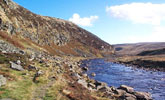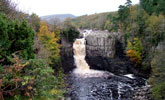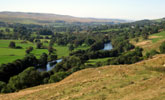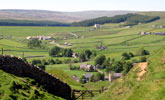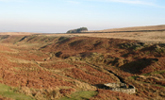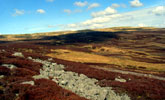North Pennines
Key Characteristics
- An upland landscape of high moorland ridges and plateaux divided by broad pastoral dales.
- Alternating strata of Carboniferous limestones, sandstones and shales give the topography a stepped, horizontal grain.
- Millstone Grits cap the higher fells and form distinctive flat-topped summits. Hard igneous dolerites of the Great Whin Sill form dramatic outcrops and waterfalls.
- Broad ridges of heather moorland and acidic grassland and higher summits and plateaux of blanket bog are grazed by hardy upland sheep.
- Pastures and hay meadows in the dales are bounded by dry stone walls, which give way to hedgerows in the lower dale.
- Tree cover is sparse in the upper and middle dale. Hedgerow and field trees and tree-lined watercourses are common in the lower dale.
- Woodland cover is low. Upland ash and oak-birch woods are found in river gorges and dale side gills, and larger conifer plantations in the moorland fringes.
- The settled dales contain small villages and scattered farms. Buildings have a strong vernacular character and are built of local stone with roofs of stone flag or slate.
- The landscape is scarred in places by mineral workings with many active and abandoned limestone and whinstone quarries and the relics of widespread lead workings.
- An open landscape, broad in scale, with panoramic views from higher ground to distant ridges and summits.
- The landscape of the moors is remote, natural and elemental with few man made features and a near wilderness quality in places.
- Within the dales there is a strong sense of cultural continuity and visual unity
Description
An upland landscape of high moorland ridges and enclosed dales. The topography is massive in scale, with broad plateaux and summit peaks in the west giving way to more divided ridges in the east. The main dales are relatively broad with substantial tributary valleys, many of which are occupied by reservoirs.
Thinly bedded limestones, sandstones, mudstones and shales of the Carboniferous Limestone and Millstone Grit series give rise to gently rounded topography with a strong horizontal grain. Alternating harder and softer strata give a stepped profile to the dale sides. Millstone Grits cap the higher fells and form distinctive flat-topped summits. The underlying rocks are masked by deep peat on higher ground and by glacial clays in the valley bottoms and outcrop only occasionally in the form of low crags or stone bands. Hard igneous dolerites of the Great Whin Sill form more dramatic outcrops and waterfalls in Teesdale. Soils range from deep peats, peaty gleys and podzols on the higher fells to heavy gleys and lighter brown earths in the dales. The higher moors have a severe climate of short summers and cold winters with high levels of rain and snowfall and strong winds.
Land use is largely pastoral with improved and semi-improved pastures and upland hay meadows in the dales giving way to rough grazing and open heather or grass moorland on higher ground. The drier eastern ridges carry a mosaic of acid grassland and heath of heather and bilberry managed by burning for grouse shooting and grazed by hardy upland sheep. The higher, wetter ridge tops and poorly drained plateaux are covered in blanket bog of heather, cotton grass and sphagnum.
Field systems in the upper and middle dale are generally regular in pattern and date largely from periods of enclosure and improvement in the 18th and 19th centuries. Field boundaries are dry stone walls of locally quarried sandstones and limestones, or more rounded boulders from rivers or field clearances. In the lower dale older field systems surround the villages, most dating from enclosures of common town fields in the 17th century. Here walls give way to hawthorn hedges with hedgerow trees of ash, sycamore and oak.
Woodland cover is low although the lower dales are well wooded in places. Upland ash and oak-birch woodlands are found in river gorges and dale side gills. Narrow alder woods or tree lines follow smaller watercourses. Pockets of Juniper scrub are found in the moorland margins. Coniferous plantations are scattered throughout the dales and there are a number of larger forestry plantations in the moorland fringe.
Villages are strung out along the floor of the dale. Those in the lower dale are typically Saxon or medieval in origin, often enlarged in the 18th and 19th centuries by housing for lead mining and quarry workers. These give way in the middle and upper dale to smaller villages, hamlets or farm clusters, many of which have their origins in the lead mining industry as do many of the small farmsteads which line the dale side. Buildings have a strong vernacular character and are built of local stone with roofs of stone flag or slate.
The landscape has been heavily influenced by mining and quarrying in places. Relics of the lead industry include prominent hushes and spoil heaps, shafts, levels, chimneys and derelict mine buildings. There are a number of active quarries and many old abandoned quarries in the dale side and moorland fringe.
The landscape is broad in scale, defined within the dales by the enclosing view line of moorland ridges. There are panoramic views of the dales from higher ground, and across intervening dales to distant ridges and summits. The landscape of the moors is remote, natural and elemental with few man made features and a near wilderness quality in places. Within the dales there is a strong sense of cultural continuity and visual unity.
Broad Landscape Types
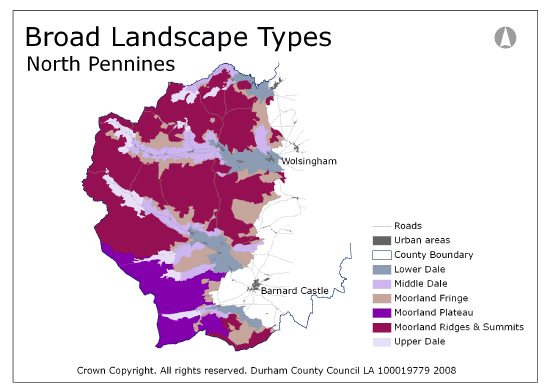
The landscape of the North Pennines can be broadly divided into moorland and dales landscapes. Moorland landscapes include the high Moorland Ridges and Summits which separate the main dales, the flatter Moorland Plateau of the Stainmore depression, and the Moorland Fringe of moorland intakes, rough grazing, wet pasture and coniferous forestry which border the dales.
Dales landscapes are transitional in character. Lower Dales, where many of the larger dales villages lie, typically have a mix of old hedgerows and dry-stone walls, frequent hedgerow trees and broadleaved woodlands. Middle Dales are more open and dominated by strong patterns of dry-stone walls enclosing upland hay meadows and pastures with scattered hamlets and farm clusters. Upper Dales are characterised by rough grazing, wet pastures and isolated farms and are similar in character to the landscape of the Moorland Fringe.


